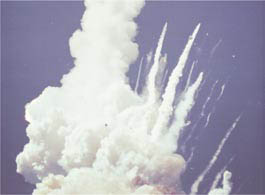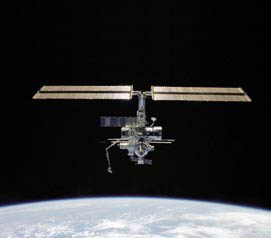1.5 THE CHALLENGER ACCIDENT
1.5 The Challenger Accident
― チャレンジャー事故 ―
― チャレンジャー事故 ―
The illusion that the Space Shuttle was an operational system, safe enough to carry legislators and a high-school teacher into orbit, was abruptly and tragically shattered on the morning of January 28, 1986, when Challenger was de-stroyed 73 seconds after launch during the 25th mission (see Figure 1.5-1). The seven-member crew perished.
スペースシャトルが議員や高校の先生を軌道上へと連れて行けるほど安全で、実用段階にあるものだという幻想は、ある日突然、幕を閉じました。1986年1月28日、チャレンジャーが25回目のミッションへの打上げの73秒後に破壊されたのです(図1-5-1)。この事故で7人の乗務員の命が失われました。

Figure 1.5-1. the Space Shuttle Challenger was lost during ascent on January 28, 1986, when an O-ring and seal in the left Solid Rocket Booster failed.
図1-5-1:スペースシャトルチャレンジャーは、
左の固体燃料ロケットブースターのOリングとシールの不良により、
1986年1月28日の打上げの際に失われました。
左の固体燃料ロケットブースターのOリングとシールの不良により、
1986年1月28日の打上げの際に失われました。
To investigate, President Reagan appointed the 13-member Presidential Commission on the Space Shuttle Challenger Accident, which soon became known as the Rogers Commission, after its chairman, former Secretary of State William P. Rogers.*18 Early in its investigation, the Commission identified the mechanical cause of the accident to be the failure of the joint of one of the Solid Rocket Boosters. The Commission found that the design was not well understood by the engineers that operated it and that it had not been adequately tested.
調査のために、レーガン大統領は、13人の大統領直属の委員会を組織しました。これはすぐに、以前国務長官を務め、本委員会の議長となったウィリアム・P・ロジャーズにより、ロジャーズ委員会として知られるようになります。*18委員会は調査の初期に、事故の機械的な原因が片方の固体燃料ロケットブースターのジョイントの不良によるものであることを突き止めました。委員会は運用を担当していた技術者が設計についてよく理解しておらず、十分なテストが行われていなかったことを明らかにしました。
When the Rogers Commission discovered that, on the eve of the launch, NASA and a contractor had vigorously debated the wisdom of operating the Shuttle in the cold temperatures predicted for the next day, and that more senior NASA managers were unaware of this debate, the Commission shifted the focus of its investigation to "NASA management practices, Center-Headquarters relationships, and the chain of command for launch commit decisions."*19 As the investigation continued, it revealed a NASA culture that had gradually begun to accept escalating risk, and a NASA safety program that was largely silent and ineffective.
打上げの前日、NASAと提携企業との間で翌日に予想されているような気温が低い時にシャトルを運用すべきかどうかについての活発な議論が行われていました。そして、NASAの上級管理職はこの議論について知りませんでした。この事実が明らかになってから、ロジャーズ委員会は調査の対象を「NASAの管理上の慣習、中央本部員同士の関係、打上げの許可に関する指揮系統」に移しました。調査が続けられる中で、次第に大きくなるリスクを徐々に受け入れて始めていたNASAの文化、そして、NASAの安全プログラムが殆ど活動しておらず、効果のないものになっていることが明らかになったのです。
The Rogers Commission report, issued on June 6, 1986, recommended a redesign and recertification of the Solid Rocket Motor joint and seal and urged that an independent body oversee its qualification and testing. The report concluded that the drive to declare the Shuttle operational had put enormous pressures on the system and stretched its resources to the limit. Faulting NASA safety practices, the Commission also called for the creation of an independent NASA Office of Safety, Reliability, and Quality Assurance, reporting directly to the NASA Administrator, as well as structural changes in program management.*20 (The Rogers Commission findings and recommendations are discussed in more detail in Chapter 5.) It would take NASA 32 months before the next Space Shuttle mission was launched. Dur-ing this time, NASA initiated a series of longer-term vehicle upgrades, began the construction of the Orbiter Endeavour to replace Challenger, made significant organizational changes, and revised the Shuttle manifest to reflect a more realistic flight rate.
1986年6月6日に発行された、ロジャーズ委員会の報告書は、固体燃料ロケットの接合部分とシールの再設計と再検査を行い、独立した組織がそれらをテストし許可を与えることを勧告しました。そして、シャトルが実用段階にあると宣言したことが、プロジェクトに大きなプレッシャーを与え、そのリソースを限界まで引伸ばしたと結論したのです。委員会はNASAの安全対策を批判し、組織的な改革だけでなく、安全性・信頼性・クオリティを保障し、それらをNASA長官へ直接報告を行う独立機関の設立を主張しました(ロジャーズ委員会の所見と勧告については第5章で扱います)。そして、次のスペースシャトルが打ち上げられるまでに36週間かかりました。この間にNASAは、長期にわたる機体のアップグレード、チャレンジャーの代替となるオービター、エンデバーの建造、大幅な組織改革を行い、シャトル計画の目標をより現実的なフライト数に修正しました。
The Challenger accident also prompted policy changes. On August 15, 1986, President Reagan announced that the Shut-tle would no longer launch commercial satellites. As a result of the accident, the Department of Defense made a decision to launch all future military payloads on expendable launch vehicles, except the few remaining satellites that required the Shuttles unique capabilities.
さらに、チャレンジャー事故は、政策の変更を促すことになりました。1986年8月15日、レーガン大統領は今後シャトルによる商業打上げを行わないことを発表し、また国防総省は、シャトルにしか打ち上げられない衛星を除き、軍用目的のペイロードには使い捨て型のロケットを使用することを決定しました。
In the seventeen years between the Challenger and Columbia accidents, the Space Shuttle Program achieved significant successes and also underwent organizational and managerial changes. The program had successfully launched several important research satellites and was providing most of the "heavy lifting" of components necessary to build the International Space Station (see Figure 1.5-2). But as the Board subsequently learned, things were not necessarily as they appeared. (The post-Challenger history of the Space Shuttle Program is the topic of Chapter 5.)
チャレンジャーとコロンビアの事故の間の17年間に、スペースシャトルプログラムはいくつもの重要な成功を収め、組織上・管理上の改革が行われました。複数の重要な衛星の打ち上げを行い、国際宇宙ステーションを建造する上で必要な「重量貨物」である殆どのコンポーネントを軌道上に運びました(図1-5-2)。しかし、我々の調査で明らかになったように、物事は必ずしも見かけ通りに行っていたわけではありませんでした(チャレンジャー以後のスペースシャトルプログラムの歴史は第5章で扱います)。

Figure 1.5-2. The International Space Station as seen from an approaching Space Shuttle.
図1-5-2:接近するスペースシャトルから見た国際宇宙ステーション